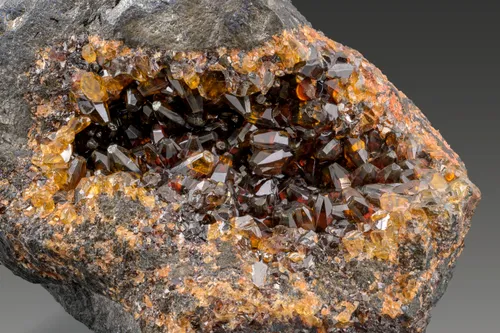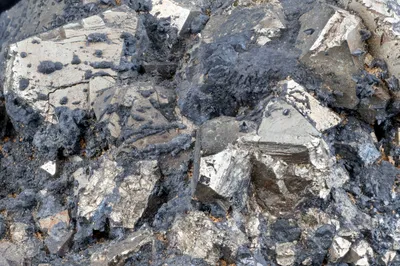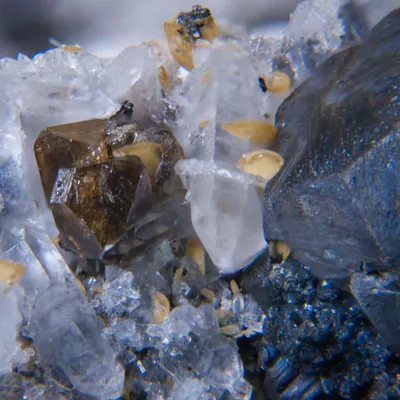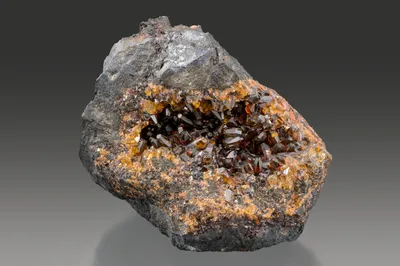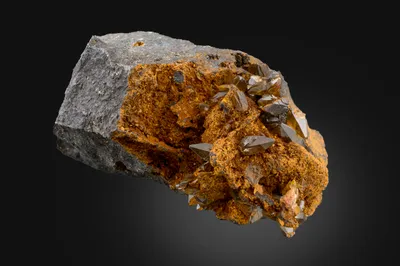
Image Credit: Malcolm Southwood
Mineral Species
Siderite
Type Locality
No
Composition
FeCO3
Crystal System
Trigonal
Status at Tsumeb
Confirmed
Abundance
Somewhat rare
Distribution
First, second and third oxidation zones
Paragenesis
Supergene
Entry Number
Species; TSNB320
General Notes
Although siderite is not particularly rare at Tsumeb, specimen-quality material is uncommon. Three occurrences of siderite stand out:
- Gemmy, yellow, or red-brown scalenohedra and modified rhombohedral crystals, to about 10 mm, lining vugs in massive chalcocite / tennantite ore, from the second oxidation zone (Pinch and Wilson 1977; Gebhard 1999).
- Brown, or beige-coloured crystals in vugs in germanium-rich sulphide ores accompanying minerals such as ludlockite and stottite (and sometimes resembling the latter). Siderite in this paragenesis typically contains up to 9 wt % zinc and has commonly been referred to as zincian siderite (Embrey et al. 1977c).
- In the third oxidation zone, on 46 Level, greenish-disc-like crystals of siderite are associated with chalcocite, and samples of this siderite may contain up to 8.5 wt % nickel (Gebhard and Schlüter 1995; Gebhard 1999).
Siderite was first reported from Tsumeb by Strunz et al. (1958a) in their description of the new mineral stottite. They included siderite in their lists of minerals for both the first and second oxidation and noted the occurrence of tiny crystals of siderite in the stottite paragenesis.
Bartelke (1976) observed that siderite was "… rarely found as small yellow to reddish-brown rhombohedral crystals".
Davis et al. (1970) and Embrey et al. (1977c) noted the occurrence of zinc rich siderite crystals on the type material for the newly described mineral ludlockite. Electron microprobe analysis of siderite from the type specimens of ludlockite (at the Natural History Museum, London; catalogue numbers BM.1969,215 and BM.1969,216) showed a zoned composition containing 9 wt % Zn at the surface, declining to 5 wt % in the core of the crystal and a bulk chemical analysis gave the empirical formula: (Fe0.675Zn0.218Ca0.056Mn0.042Mg0.005Pb0.004)CO3.
Siderite forms a complete solid solution series with smithsonite, but the range of compositions at Tsumeb has not been fully investigated.
Pinch and Wilson (1977) described:
"Dark yellow to golden brown crystals and masses. The crystals range from needles to fine scalenohedral crystals capped by rhombohedron faces and reaching several mm in size; the latter type form attractive druses of water-clear dark golden brown crystals in pockets in sulfides".
Gebhard (1999) described "… world class" specimens of siderite comprising "… shiny yellow to red crystals of about 1 cm …" on a matrix of massive chalcocite and tennantite from the second oxidation zone. He noted, however, that much smaller crystals of siderite, typically in vugs in germanite-rich ore are much more common and that these zinc-rich siderites were commonly mistaken for stottite (with which they sometimes occur).
From the third oxidation zone, on 46 Level, Gebhard and Schlüter (1995) observed green disc-like crystals of siderite containing up to 8.57 wt % NiO, 7.4 % MgO and 2.2 % ZnO. These unusual siderite crystals are associated with chalcocite, stolzite, scheelite and (according to Gebhard 1999) hematite. The Ni-rich siderite crystals were individually up to 2 mm but formed aggregates to 10 mm across. Gebhard and Schlüter (1995) noted that this was the first time a mineral with significant nickel content had been found at Tsumeb.
Siderite is named as an associated mineral in the descriptions of the following new minerals from Tsumeb: ludlockite (Embrey et al. 1977b); otjisumeite (Keller et al. 1981c); stottite (Strunz et al. 1958a) and tsumgallite (Schlüter et al. 3003).
Associated Minerals
bendadaite; bornite; brunogeierite; cerussite; chalcocite; fraipontite; germanite; hematite; karlseifertite; krieselite; leiteite; lepidocrocite (?); ludlockite; ojuelaite; otjisumeite; powellite; prosopite; pyrite; quartz; renierite; schaurteite scheelite; schneiderhöhnite; söhngeite; stolzite; stottite; thaumasite; tsumgallite
